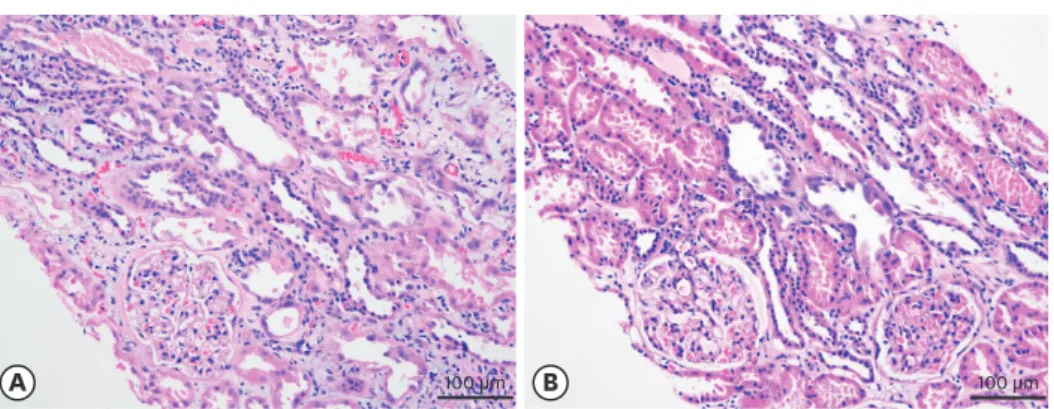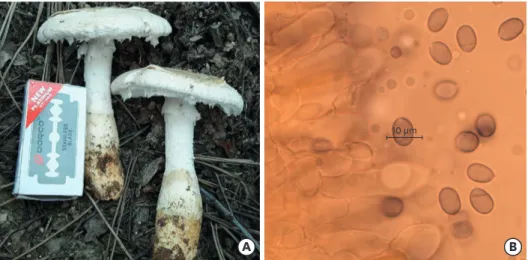1/3 https://jkms.org
A 67-year-old man and his wife, a 63-year-old woman, were referred with elevated serum creatinine (s-Cr) levels. He had no known underlying disease and she had pre-existing hypertension and dyslipidemia, for which she was taking amlodipine 5 mg/day and
rosuvastatin 10 mg/day. Three days prior, they ate wild mushrooms that looked like Tricholoma matsutake, which is very expensive in Korea. The next day, they developed generalized weakness, nausea, and loose stools. They firstly visited private clinics and received symptomatic treatment. However, the creatinine level of the couple was increased to 9.79 mg/dL in the man (normal range: 0.8–1.2 mg/dL) and 3.06 mg/dL in the woman. They did not complain of fever, chills, abdominal pain, or anuria. Acute kidney injury (AKI) was suspicious on ultrasonography findings in both. We performed renal biopsy and revealed tubular dilatation with tubular epithelial flattening, coagulative necrosis of the tubular epithelial cells with an intraluminal granular cast, and extensive regenerative changes (Fig. 1A) in the man. His wife's renal biopsy also showed acute tubular necrosis (ATN) with epithelial cell regeneration (Fig. 1B). Therefore, conservative treatment without RRT was continued with crystalloids 1–2 mL/kg/hr. On hospital day (HD) 4, s-Cr elevated at 11.4 mg/dL. After HD 4, his urine output increased to 3,000–4,000 mL/day and on HD 14, his creatinine level had improved to 2.4 mg/dL. His wife's lab values also normalized on HD 8. We asked a mycologist to get mushrooms from the mountains which the couple took the mushrooms and the leftover mushrooms in the patients' refrigerator. She identified them with Melzer's reagent and morphology as Amanita neoovoidea (Fig. 2).
J Korean Med Sci. 2018 Sep 17;33(38):e230 https://doi.org/10.3346/jkms.2018.33.e230 eISSN 1598-6357·pISSN 1011-8934
Images in This Issue
Received: Apr 17, 2018 Accepted: Jun 14, 2018 Address for Correspondence:
Eun Hui Bae, MD, PhD
Department of Internal Medicine, Chonnam National University Medical School, 42 Jebong-ro, Dong-gu, Gwangju 61469, Republic of Korea.
E-mail: baedak@hanmail.net
© 2018 The Korean Academy of Medical Sciences.
This is an Open Access article distributed under the terms of the Creative Commons Attribution Non-Commercial License (https://
creativecommons.org/licenses/by-nc/4.0/) which permits unrestricted non-commercial use, distribution, and reproduction in any medium, provided the original work is properly cited.
ORCID iDs Jeong Ho Lee
https://orcid.org/0000-0002-2300-0826 Sung Sun Kim
https://orcid.org/0000-0002-8569-2178 Soon Ja Seok
https://orcid.org/0000-0001-9087-4163 Eun Hui Bae
https://orcid.org/0000-0003-1727-2822 Disclosure
The authors have no potential conflicts of interest to disclose.
Author Contributions
Conceptualization: Bae EH. Data curation: Lee JH. Methodology: Kim SS, Seok SJ. Writing - original draft: Lee JH. Writing - review &
editing: Bae EH.
Jeong Ho Lee ,1 Sung Sun Kim ,2 Soon Ja Seok ,3 and Eun Hui Bae 1
1Department of Internal Medicine, Chonnam National University Medical School, Gwangju, Korea
2Department of Pathology, Chonnam National University Medical School, Gwangju, Korea
3 Agricultural Microbiology Team, National Academy of Agricultural Science, Rural Development Administration, Suwon, Korea
Acute Kidney Injury Resulting from Amanita neoovoidea Intoxication
Medical Imaging
100 µm 100 µm
A B
Fig. 1. Attenuation of tubular epithelial cells with intraluminal proteinaceous cellular debris is noted.
Regenerative changes, such as pleomorphic hyperchromatic nuclei, basophilic cytoplasm, and occasional mitotic figures, are also noted. Intraluminal granular casts, interstitial inflammatory cells, and red blood cells extravasation is also present. (A) Husband's kidney biopsy and (B) his wife's kidney biopsy (magnification × 200).
The fungal genus Amanita is divided into seven sections.1 A. neoovoidea, like Amanita ovoidea, are grouped in the section Amidella within the species Amanita. It is found in areas from middle Japan to China and Nepal.2 The genus Amanita contains both edible and inedible forms, including dangerous and sometimes even deadly ones. Despite the number of studies performed on this genus, the toxicity of some species, such as the group of white fungi, remains indeterminate.3 According to previous reports, Amanita virosa, Amanita verna, and Amanita subjunquillea are leading causes of mushroom poisoning in Korea.4 Thirty-five patients showed marked elevations in alanine aminotransferase (ALT), and 7 patients died because of AKI and hepatic failure. Amanita punctata has been reported as a cause of acute renal failure in Korea.5 The clinical symptoms in this case resemble the course observed with Amanita smithiana poisoning in Western North America.6 These findings are similar with cases of poisoning due to the A. smithiana toxin, the same toxic agent found in A. neoovoidea, which caused several cases of poisoning in the United States from 1986.7,8 The A. smithiana was ingested raw or after cooking. Symptoms appeared in 4 to 10 hours, including vomiting, diarrhea, and abdominal pain, and after 2 to 3 days complete, but reversible, renal failure occurred.7,8 Amanita nephrotoxic syndrome refers to mushroom poisoning characterized by early onset of gastrointestinal symptoms, mild ALT elevation, and AKI with acute interstitial nephritis.1 Our patients had ATN rather than acute interstitial nephritis with regenerating epithelial cells. This suggests that it is a direct toxin effect rather than an immunologic response.
In conclusion, A. neoovoidea might induce AKI and it would be wise not to ingest wild mushrooms except after proper identification by a trained mycologist.
REFERENCES
1. Kirchmair M, Carrilho P, Pfab R, Haberl B, Felgueiras J, Carvalho F, et al. Amanita poisonings resulting in acute, reversible renal failure: new cases, new toxic Amanita mushrooms. Nephrol Dial Transplant 2012;27(4):1380-6.
PUBMED | CROSSREF
2. Tulloss RE, Hongo T, Brandary HR. Amanita neoovoidea-taxonomy and distribution. Mycotaxon 1992;44(1):235-42.
2/3 https://jkms.org https://doi.org/10.3346/jkms.2018.33.e230
Amanita neoovoidea-induced AKI
10 µm
A B
Fig. 2. Amanita neoovoidea eaten by patients. (A) Gross image of the A. neoovoidea. (B) Carpophores of A.
neoovoidea, cause amyloid reaction in Melzer's reagent (magnification × 100).
3. Biagi M, Martelli L, Perini C, Lella LD, Miraldi E. Investigations into Amanita ovoidea(Bull.) link.: edible or poisonous? Nat Resour 2014;5(6):225-32.
CROSSREF
4. Ahn BM, Lee DS, Lee KM, Kang SB, Yang JM, Park YM, et al. Amatoxins poisonings in Korea. Korean J Hepatol 2000;6(3):340-9.
5. Kang E, Cheong KY, Lee MJ, Kim S, Shin GT, Kim H, et al. Severe but reversible acute kidney injury resulting from Amanita punctata poisoning. Kidney Res Clin Pract 2015;34(4):233-6.
PUBMED | CROSSREF
6. West PL, Lindgren J, Horowitz BZ. Amanita smithiana mushroom ingestion: a case of delayed renal failure and literature review. J Med Toxicol 2009;5(1):32-8.
PUBMED | CROSSREF
7. Cochran KW. Poisonings due to misidentified mushrooms. McIlvainea 1987;8(1):27-9.
8. Lampe KF. NAMA poisoning registry-1988. McIlvainea 1988;9(1):28-30.
3/3 https://jkms.org https://doi.org/10.3346/jkms.2018.33.e230
Amanita neoovoidea-induced AKI

